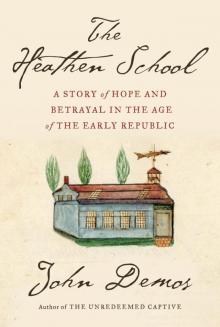- Home
- John Demos
The Heathen School Page 9
The Heathen School Read online
Page 9
En route they stop in the West Indies, at the island of Grenada, where Johnson is suddenly stricken with yellow fever. When his case seems hopeless, he is wrapped in blankets and left to die on a beach. Fortunately, he is found by “a gentleman … taking an evening walk … with his lady,” carried to their home, and nursed back to health. Eventually, he secures passage on yet another American ship, and debarks in the town of Derby, Connecticut. From there he removes to the neighboring village of Woodbridge, is hosted by the local minister, and is eventually referred to the agents of the Mission School. He is admitted despite (or because of?) pronouncing himself “a Mahometan [sic] by habit,” and seeming “very bigoted, saying his prayers to the prophet four times a day.” This is but a prelude to Christian conversion; within days he begins “to doubt the divine mission of Mahomet,” and to feel “great reverence for the Scriptures.” His teachers find him to be “diligent and studious.” And the fact that he speaks both Hebrew and Arabic makes them regard him as “an important acquisition.” Indeed, considering “the remarkable leadings of Providence” that brought him to Cornwall, they feel certain of his destiny “to be an instrument of good in some station.” (Another legend? Perhaps—in some parts. But the weave of the Mission School story would include such strands over and over again.)
Thus the total number of students by summer’s end was an even dozen: seven from Hawaii, two from India, one Native American, plus the two Yankees. Their ages spanned a range from mid-teens to early thirties. Their prior experience was enormously diverse: seafaring, most especially, but also military service, farming, barbering, cooperage, “academy” schooling. Their educational levels, and their language skills in particular, were equally varied; one or two were nearly illiterate, while others had been tutored for months or years in Latin, Greek, and Hebrew. (And John Johnson, as noted, spoke Arabic.) Perhaps the first, most pressing problem their instructor would face was finding common ground among them.
Within the full cast here, Henry Obookiah was clearly the star—the leader and emblem of the entire project for the world at large. In a long letter sent to one of his erstwhile “patrons” in early June, he began by applauding his fellow scholars’ “great progress in their studies”; the latter included English grammar, geography, and arithmetic, together with reading, writing, and spelling. (Some, however, “were just beginning to read.”) The daily program centered on classes “from nine to twelve, and from two to five.” School rules forbade visits “to any house or … any family in town.” Moreover, none may “go to a store (unless they have a liberty).” By the same token, “no visitor or friend should call to see any that is in the school.” Even within the grounds, there were restrictions. The “study hour,” for example, was sacrosanct; at such times, “no student shall come into another’s room.” Finally, all must “take part in laboring … two [and] ½ days … a week … two at a time.” This last referred to work on the school’s agricultural property, something Obookiah considered “as important … as to learn to read and write.” His opinion was not widely shared among his fellows, some of whom had “very little acquaintance with farming business … and so they…[do] not delight in it.” (Most, he noted, “understand [more] about the sailor’s business,” having previously served for long periods at sea.)13
Obookiah’s description sets a kind of frame; additional details lie scattered here and there in missionary writings. From the start, the focus of school authorities—both teachers and agents—went as much toward conversion as toward standard pedagogical fare. Sometimes religious faith lapped over directly into the classroom. A text entitled The Missionary Spelling Book and Reader, said to have been “prepared at the Foreign Mission School … and designed especially for its use,” combined language training with key articles of faith. The latter included such familiar homilies as “We shall all die”; “Angels will come and take the souls of good men up to heaven”; and “The souls of wicked men will go to hell…[where] they will dwell with devils and be miserable forever.” Cornwall’s First Church was the one place where scholars might meet on a regular basis with the local populace. Their attendance each Sabbath was expected, indeed assumed. They were assigned a special “bench … in the [church’s] southeast corner.” One imagines them seated in close array, decked out in their Sunday finest (most of it garments donated by school supporters), and enduring—perhaps enjoying, perhaps embarrassed by—the inevitable glances thrown their way. For certain, they were on display.14
Obookiah was the lone scholar previously qualified for full church membership; according to one account, “he appears to grow in grace, and more and more to evince the reality of his new birth.” But several of his fellows were pointed in the same direction. Hopoo, in particular, had “for about two years entertained a hope in Christ”; hence, in midsummer, he was “admitted to the church, and received the ordinance of baptism.” Tennooe and Honoree showed promising signs of “having passed from death unto life.” Sandwich had “become deeply impressed with the concerns of his soul.” Kummooolah appeared to be “the subject of religious exercises of some kind,” though “from ignorance of our language he [was]…unable to give an account of them.” The same “concerns,” the same “exercises,” the same accompanying language of pious hope would infuse reports of Mission School life virtually to its close.15
At the other end of a long spectrum—from God to mammon—lay pressing concerns with money. Many of the start‑up costs, such as those to enable the purchase of land and buildings, had been covered by the American Board, but that source would not suffice for regular operations. Instead, the school must develop a full-scale fund-raising program, to tap the rapidly mounting public interest in missionary outreach. Already some steps had been taken. Several regional canvassers were in place and at work—for New England, New York, New Jersey, and points farther south—and Rev. Stone stood ready to coordinate their efforts from Cornwall itself. During the course of the school’s first summer, a sum of $1,400 was raised in eastern Massachusetts; in the town of Newburyport alone (as a local reporter proudly noted), “two hundred and thirty-two dollars and fifteen cents were contributed in one evening, besides several articles of jewelry.” There and elsewhere “female societies,” even “societies of children,” were forming “for the promotion of the same object.” “Missionary fields” were planted in many communities—farm lots set aside to yield produce for consumption (or sale) at the Mission School. Collection plates, “charity boxes,” “concerts of prayer,” and other such stratagems were also noted on the lists.16
In the months to come, fund-raising for the school would mushroom astoundingly. Thousands of ordinary folk would come forward to contribute—most at quite modest levels, but with no less commitment for that. Stone would arrange the printing of lengthy “donations lists” in missionary periodicals. And these, in turn, were meant to prompt additional swelling of the ranks. Read today, they are affecting documents; more than anything else, they limn the shape of evangelical fervor at ground level.17
Many of the gifts were in cash. Some came from named individuals:
Esq. Battle of Norfolk (Con.) $ 5.00
Mrs. Battle, of the same place 5.00
Moses Woodruff, proceeds of a garden 1.40
Gratuities of the public house, of Mr. T. Cowles, New Hartford 1.75
Some were anonymous:
A Friend to the School 10.00
A widow’s mite 0.55
Avails of Cider Collected by Several Persons and Sold 4.80
Avails of Gold Leaf, saved by a few Young Ladies in Terry’s clock manufactory 30.00
From three little boys 0.12½
From a Lady in New Fairfield, the avails of a prize ticket 05.00
A highly respectable clergyman (Episc.), when visiting the school 5.00
From the colored people in Utica and New Hartford, N.Y. 12.00
Some came from organizations:
The Owhyean Society of Young People in Augusta, N.Y. 2.00
A Female Charitable and Praying Society in Westford, Otsego County, N.Y. Cash twenty dollars
Some might set a little scene:
Mr. H. N. Crosby of N. East (N.Y.) is thanked for his generosity to the scholars of the institution, at the time of his exhibition of a number of interesting, living animals at Cornwall………. he giving of 340 cents
Many were in-kind gifts, not cash:
Mr. Samuel Street of Goshen: 4½ bu. of potatoes, 50 lbs of veal
1 bushel of white beans from a missionary field
9 bushels of garden vegetables estimated at 2 dollars
One shirt given on his deathbed by William R. Hawley
Scaghticoke tribe of Indians, Sophia Rice: one sailor coat
A quantity of straw hats
Cloth for a pair of pantaloons
Quills, 1 ream of paper
1 bureau, 1 breakfast table, 1 doz. candle snuffers
Rollins Ancient History in 8 handsome volumes
Tyringham, Mass., a few ladies of the society of the Rev. Mr. Dow, 1 bed quilt, 1 shirt, 1 vest, 2 pair of socks, also 1 blanket from Miss Thankful Brown
Some were given as labor performed:
Sewing $ 1.12
Tailoring 3.00
Grinding 3 new axes
These bits—they are no more than that, and just a tiny fraction of the whole—suggest how deeply interest in the Mission School would permeate everyday life in the outside world. Towns and villages in at least a dozen different states; taverns, factories, churches, private homes; farming, cider making, weddings, holiday celebrations, circus exhibitions, prize lotteries; individuals of every rank and station, from gentlemen dubbed “Esquire,” to penurious widows and small children, to Indians and colored folk: All were represented here. Moreover, “innumerable local societies formed for the aid of the enterprise.” Variously called “Owhyhean [Hawaiian],” “Ladies Aid,” “Dorcas,” “Young People’s Mite,” and so on, all would serve to funnel valuable assistance directly into school coffers.
As news spread, the range of donors widened steadily—including, among others, the new president of Yale College (Timothy Dwight had recently died), a large group of “concerned students” at Princeton, and “the girls of Miss Pierce’s School at Litchfield.” A collection in Charleston, South Carolina, raised nearly $400. Overseas contributions came from “a Liverpool gentleman” and another in Cuba. Sometimes a published list would conclude with a special plea from Stone, designed to shape the next round of donations. For example: “Shoes and boots of a strong texture, and hats also are wanted more than any other articles.” Or: “As the colder season will soon commence, cloth and garments suitable for winter are solicited.” The “friends” and supporters would read, would take to heart, would respond accordingly.18
Alongside the accounts of donations, so carefully recorded one by one, were others that periodically summed the receipts. One such, from a year and a half after the school’s founding, was focused on bedding and “vestitures” (clothing); its forty-four categories included the following: “13 feather beds [mattresses], 63 linen sheets, 66 quilts, 135 pillow cases, 31 coats (partly worn), 61 pantaloons (partly worn), 137 vests (partly worn), 270 pairs of stockings, 79 shirts, 49 cravats, 6 surtouts [overcoats], 5 pairs of suspenders, 58 towels, 4 shaving soaps.” (One special curiosity here: 2 buffalo skins.)
The various lists, taken together, afford a glimpse of life inside the school. The furnishings they included—bureaus, breakfast tables, and the like—suggest a domestic environment closely fitted to mainstream American models; likewise the accessories, right down to lowly “candle snuffers.” The clothing, too, expressed local taste and preference. (Some may have come literally off the backs of previous wearers—for example, the shirt given by a man “on his death-bed.”) The foods—meat, potatoes, beans, garden vegetables—were staples of New England diet. Nothing at all acknowledged an alien element. To visit the school would mean encountering things known and familiar, with the crucial exception of the persons of the scholars themselves. But these, too, could be remade in time—which was, of course, the point of it all.
Indeed, the entirety of school operations conformed to well-established precedent. The curriculum described in Obookiah’s early letter—English grammar, geography, arithmetic, together with reading, writing, and spelling—would be augmented as time passed. Additional subjects would include rhetoric, composition, natural philosophy, astronomy, and the classical languages, all of them standard fare in a typical academy education of those years. Another traditional element was the scheduling, at appropriate intervals, of public “examinations” or (as they were also called) “exhibitions.” These were times for the scholars to give formal demonstration of their prowess in front of staff, sponsors, and other concerned parties (such as Cornwall townspeople). First, they would be examined in their various “academical” subjects; then they would pray and sing; finally, they would enact skits, speeches, and other little dramas that exemplified the “savage” ways they were leaving behind and the “civilized” ones they were seeking to embrace. These performances would be long remembered by all who witnessed them. As one admiring onlooker wrote some years later, “The students spoke on stage, first in their own tongue, then in our language.… The Indian pupils [in particular?] appeared so genteel and graceful … that the white pupils appeared uncouth beside them.… When they prayed, they knelt, clasped their hands together, and held them up. When they sang, they sat in a row, and all waved their hands simultaneously.” Typically, the program would culminate with a sermon by a locally prominent minister. As much as possible, this should be a bravura performance, lavishly underscoring current accomplishments and inspiring high hopes for the future. Inspiration was a currency on which the school relied for emotional and moral—as well as financial—sustenance. Thomas Gallaudet, founder of the Hartford Deaf and Dumb Asylum, would say of one particular exhibition: “[I]t was more interesting … than a hundred college commencements.” And on the same occasion John Treadwell, governor of Connecticut, “was completely carried away…& thought it beyond everything he had seen or ever expected to see here.”19
The first of these events was announced for a certain “Wednesday in September [1817]…at 9 o’clock a.m.” Barely four months had passed since the beginning; however, there was pressure to show quick “improvement” to the public—to disarm skeptics and rally supporters. According to a subsequent report, the audience that day included “several of the neighboring clergy, and a number of ladies who have taken an interest in these youths.” (There is something unwittingly ironic, and prophetic, about the wording there—ladies who have taken an interest in these youths—given all that would follow in the history of the school.) Apparently, the proceedings went well; at least “the students acquitted themselves to the satisfaction of those present.” They proved especially adept with grammar and arithmetic; they also produced some “handsome specimens of penmanship.” Their “greatest difficulty” was in spelling.20
These “exercises” filled the morning. In the afternoon, the entire assemblage adjourned to the First Church to hear a sermon offered by “the Rev. Mr. [Charles] Prentice” (one of the school’s governing agents). Only its biblical text is known today—Matthew 13:16–17—but this was admirably suited to the moment: “Many prophets and righteous men have desired to see those things which ye see, and have not seen them, and to hear those things which ye hear, and have not heard them.” In other words: What you have witnessed today is utterly special; you are fortunate and privileged beyond the lot even of holy men of old. The effect was to underscore the performance of the scholars, its meaning and significance for God’s plan. These youths, so recently reclaimed from heathen darkness, are the carriers of a transcendently important change in human affairs. Nothing could have been better calculated to lift the spirits and refresh the souls of all who listened.21
The program concluded with the reading of a “register of behavior” and the award of “premiums” (prize
s) to the two “highest” named there. The first premium went to George P. Tamoree (which may have been quite a surprise, given his previously spotty record), the second to Hopoo. It was noted also that Obookiah and the two Americans were omitted from consideration, since they had been gone—presumably on fund-raising trips—for part of the summer. Of the others, who were not similarly honored, impressions were still very favorable. One was deemed “eminently useful,” another “steady and free from vicious habits,” still another “remarkably amiable and affectionate.”22
All in all, the agents felt confident of still greater success ahead: “We can have students as fast as we can accommodate them and support them. Several are now waiting for permission to join the school.” Moreover: “[T]he plan of the school meets with such universal approbation, and the conduct of the students has been so regular and respectable, as to gain the affection not only of the people of Cornwall but of all the surrounding towns.” Finally came this most ebullient flourish of all: “The Lord hath helped us. His hand has been conspicuous in every stage of the institution. And when we look forward, the most encouraging prospects are presented. We hope ere long to see this small stream become a river which shall make glad the city of our God.” From now on—the world would know—the school was on its way.23

 The Enemy Within
The Enemy Within Puritan Girl, Mohawk Girl
Puritan Girl, Mohawk Girl The Heathen School
The Heathen School